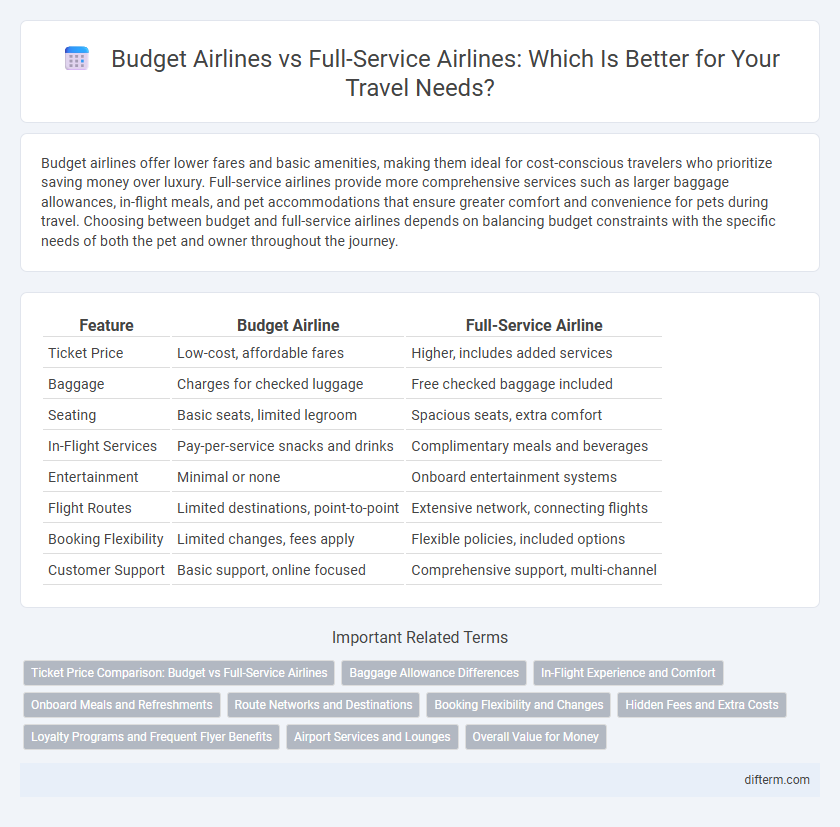Budget airlines offer lower fares and basic amenities, making them ideal for cost-conscious travelers who prioritize saving money over luxury. Full-service airlines provide more comprehensive services such as larger baggage allowances, in-flight meals, and pet accommodations that ensure greater comfort and convenience for pets during travel. Choosing between budget and full-service airlines depends on balancing budget constraints with the specific needs of both the pet and owner throughout the journey.
Table of Comparison
| Feature | Budget Airline | Full-Service Airline |
|---|---|---|
| Ticket Price | Low-cost, affordable fares | Higher, includes added services |
| Baggage | Charges for checked luggage | Free checked baggage included |
| Seating | Basic seats, limited legroom | Spacious seats, extra comfort |
| In-Flight Services | Pay-per-service snacks and drinks | Complimentary meals and beverages |
| Entertainment | Minimal or none | Onboard entertainment systems |
| Flight Routes | Limited destinations, point-to-point | Extensive network, connecting flights |
| Booking Flexibility | Limited changes, fees apply | Flexible policies, included options |
| Customer Support | Basic support, online focused | Comprehensive support, multi-channel |
Ticket Price Comparison: Budget vs Full-Service Airlines
Budget airlines offer significantly lower ticket prices by minimizing onboard services and charging extra for amenities such as checked baggage and seat selection. Full-service airlines include additional benefits like meals, in-flight entertainment, and higher luggage allowances in their ticket price, resulting in higher base fares. Travelers prioritizing cost savings often choose budget carriers, while those valuing comfort and convenience may prefer full-service airlines.
Baggage Allowance Differences
Budget airlines typically offer lower ticket prices by limiting free baggage allowance to only a small carry-on bag, while charging extra for checked luggage. Full-service airlines include more generous baggage policies with larger free checked baggage limits and sometimes additional carry-on items. Understanding these differences can help travelers avoid unexpected fees and better plan their packing strategies.
In-Flight Experience and Comfort
Budget airlines typically offer basic seating with limited legroom and minimal in-flight amenities, prioritizing cost savings over passenger comfort. Full-service airlines provide spacious seats, reclining options, complimentary meals, and in-flight entertainment systems, enhancing overall passenger experience. The choice between budget and full-service airlines significantly impacts travel comfort, especially on long-haul flights.
Onboard Meals and Refreshments
Budget airlines typically offer limited or no onboard meals and refreshments, often requiring passengers to purchase snacks and drinks separately, which helps reduce ticket prices. Full-service airlines provide complimentary meals and beverages, including a wider variety of options catering to dietary preferences, enhancing the overall travel experience. Passengers prioritizing comfort and convenience often choose full-service carriers despite higher fares, while budget carriers appeal to cost-sensitive travelers.
Route Networks and Destinations
Budget airlines typically offer limited route networks focused on short-haul and regional destinations, optimizing for high-frequency, point-to-point travel. Full-service airlines maintain extensive global route networks, including long-haul international flights and multiple hubs, enabling broader destination access and better connectivity. Travelers seeking diverse routing options and seamless transfers often prefer full-service carriers, while budget airlines cater to cost-conscious passengers prioritizing direct routes.
Booking Flexibility and Changes
Budget airlines typically offer limited booking flexibility with strict change policies and fees, making last-minute adjustments costly or restricted. Full-service airlines provide more accommodating change options, often including free or low-cost modifications within a specific timeframe, enhancing traveler convenience. Choosing an airline depends on balancing cost savings against the need for flexible travel plans.
Hidden Fees and Extra Costs
Budget airlines often advertise lower base fares but frequently charge for essentials like checked baggage, seat selection, and onboard meals, leading to unexpected hidden fees that increase total travel costs. Full-service airlines typically include these amenities in the ticket price, offering a more transparent pricing structure and reducing surprises at checkout. Travelers comparing airlines should carefully evaluate baggage policies, seat fees, and meal provisions to accurately assess overall value and avoid costly extras.
Loyalty Programs and Frequent Flyer Benefits
Budget airlines typically offer basic loyalty programs with limited rewards and fewer frequent flyer benefits, focusing on cost savings rather than extensive perks. Full-service airlines provide comprehensive loyalty programs featuring tiered membership levels, lounge access, priority boarding, and bonus miles, enhancing overall travel experiences for frequent flyers. These robust programs encourage customer retention through exclusive upgrades and partner airline alliances.
Airport Services and Lounges
Budget airlines typically offer limited airport services, with minimal lounge access and fewer amenities, prioritizing cost efficiency over comfort. Full-service airlines provide extensive airport services including premium lounges, priority boarding, and dedicated check-in counters, enhancing the overall travel experience. Access to spacious lounges with complimentary food, beverages, and Wi-Fi is a key differentiator for full-service carriers compared to budget airlines.
Overall Value for Money
Budget airlines offer lower base fares by eliminating extras such as free meals and checked baggage, making them ideal for price-sensitive travelers seeking cost efficiency. Full-service airlines provide comprehensive amenities, including in-flight entertainment, meals, and flexible ticket options, delivering higher comfort and convenience that justify the premium price for many passengers. Evaluating overall value for money depends on individual preferences for comfort versus affordability and the total travel cost when factoring in additional fees.
budget airline vs full-service airline Infographic

 difterm.com
difterm.com